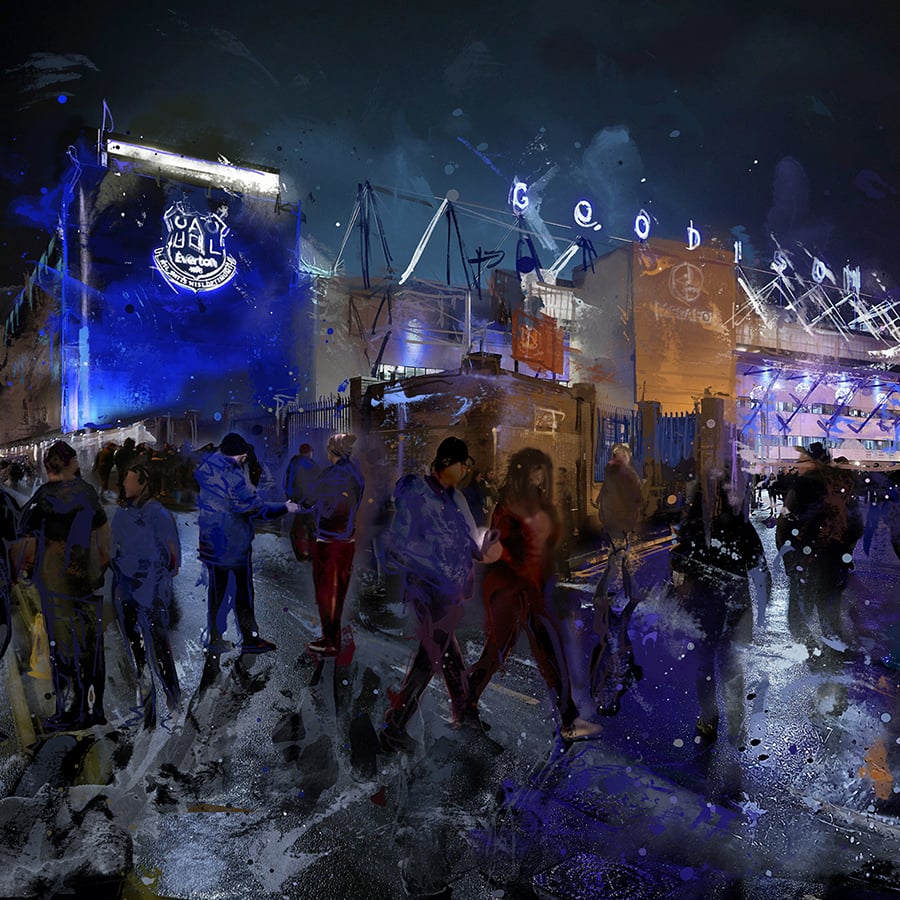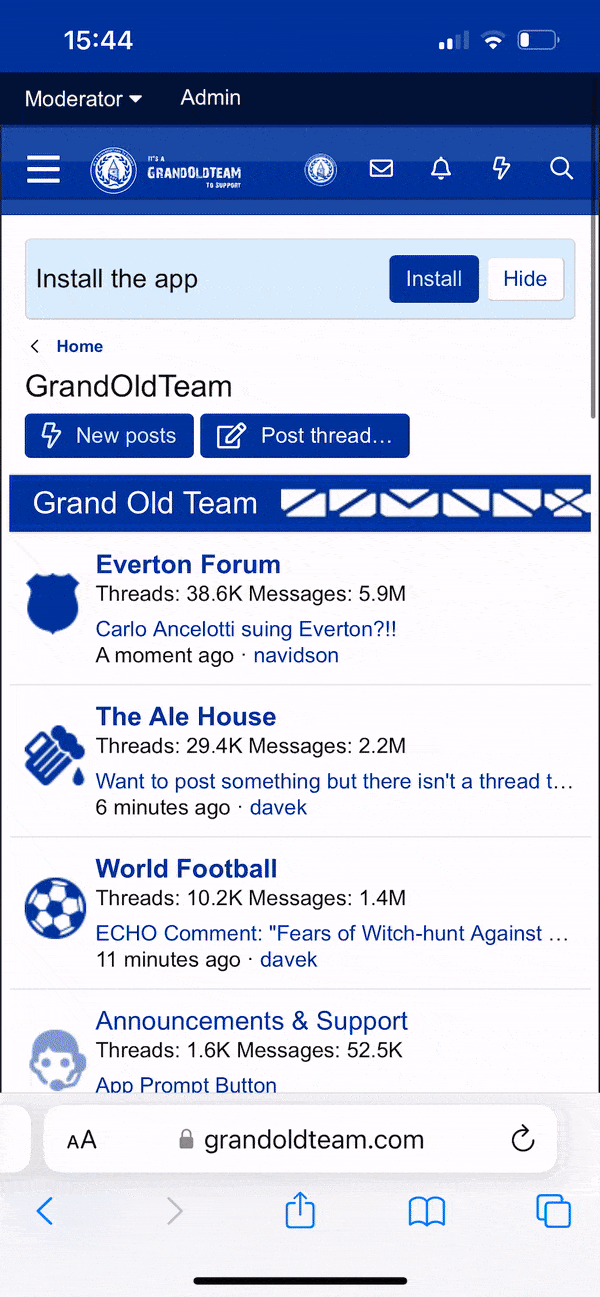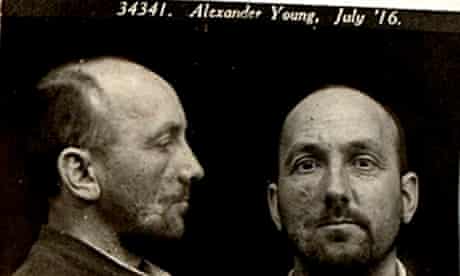Wow, I just looked up the match details and the Blues' winner was scored by Alex "Sandy" Young.
Never knew we had two of them. There must be a very good chance this one also had a golden head of hair!!
He emigrated to Australia & got convicted for murder of his brother --
The forgotten story of … Alex 'Sandy' Young
The tale of Everton's FA Cup hero and No2 all-time league scorer who emigrated to Australia and killed his brother
Sandy Young in 1916. Photograph: Public Record Office Victoria
Tongala is a fairly unremarkable, low-rise Australian outback town 140 miles due north of Melbourne that is home to 1,623 people and quite a few more cattle. According to Maggi, whose range of instant soups, stocks and sauces is made in a small Nestle factory there, it is "famous for its great tasting milkshakes, a golden cow and a tribute to the light horse brigade".
The Golden Cow Dairy Education and Tourism Centre, Tongala's premier family-friendly visitor attraction, boasts that they make the finest milkshakes in all Australia, in no less than 39 flavours. But Tongala has one other claim to fame: it was here, nearly 100 years ago, that a once-great Scottish striker took up another, altogether more lethal, form of shooting.
Alex "Sandy" Young was Everton's match-winner in the 1906 FA Cup final, the First Division's leading marksman the following season and remains No2 on their list of all-time league scorers. He went on to play, less memorably, for Tottenham Hotspur and Manchester City. An intriguing personality, the Liverpool Echo described him as "one of the most fascinating players that ever toed a ball" – and that was before he emigrated to Australia and killed his brother.
He and John must have got on well enough once, for Alex funded the initial purchase of a farm near Tongala in 1911, and then moved there himself in 1914, at the end of his playing career. But once he arrived they found that despite their common geography, livelihood and genetics the relationship foundered. They argued forcefully and frequently, sometimes with the aid of sticks, forks and shovels.
What bothered them most was money, with John continuing to borrow large sums from his brother, and never paying them back. On 30 November 1915, a friend witnessed an argument which ended with Alexander threatening to seize control of the farm. "What about these cows, half of them belong to me," protested John. "I don't think so," countered Alexander, "my cheque paid for them." As the friend left, Alexander told him: "I cannot stop here, I am afraid John will murder me." Separately, John said: "Don't go away yet, I am afraid Alick will come out and shoot me." As it turned out, one of them was right.
The following morning, as John worked in the milking shed, Alexander came out and shot him. It took him most of the day to die, and before he did he told police what had happened in the barn: "I was milking a cow when Alexander came up and said, 'I am going to shoot you.' I replied, 'Put the gun away. You are only trying to frighten me.' Alexander, though, took no notice, and fired at me."
Sandy initially described a similar chain of events but later insisted that he had fired only after John had chased him for 40 yards across the farmyard wielding a shovel. "I went to the cow-shed, where I asked him about my money," he told the court. "John got up and rushed at me with a shovel. I ran away, and he followed. I stopped and said, 'Stand, or I'll shoot.' He made a rush and said, 'Come on, fire.' I fired, and he fell. I took up the shovel and went to my house and shot myself in the head. I do not remember anything after that." One local newspaper, the Riverine Herald, described the affair as "a tragedy unequalled in the history of the district" that "rudely disturbed the rural peace and quietude of life in the Tongala settlement".
There is no footage of Young in happier times, with the ball at his feet. In the build-up to the 1906 Cup final, the Echo described him as "a variable sort of man who plays one good game in three on average", and whose "determination makes up for a lack of skill at times". Either he improved markedly thereafter or the writer didn't watch a lot of football, for by the time he was sold in 1911, after a decade at the club, the very thought of him leaving prompted unprecedented protests.
"I have been a regular attender at the Everton matches since the days of [Poor language removed] and Dobson [in the 1880s], and I unhesitatingly affirm that Sandy Young is the greatest forward that has ever played under the club's colours. Young has been and still is the club's greatest asset," wrote one fan in the Liverpool Echo.
"A vast number of supporters will refrain from visiting Goodison Park next season if their favourite is missing from the home ranks," sniffed another. "I myself (22 years a supporter) and many friends, Everton followers, have expressed the determination to withdraw our support if Sandy is not re-signed." He was not re-signed, but was cheered to the rafters when he returned that September, in Tottenham's colours, and scored in a 2-2 draw. "Of all the receptions I have ever heard that day's volume led the lot," reported the Echo.
"He was known for his intricate yet easily-performed dribbling," the paper wrote, on the day he sailed for Australia in May 1914. "His dribbling was fashioned after the old school of dribbling, and the present age would be all the better for a little genius on the part of the forwards." In 1926 the Mirror declared him "probably the greatest football artist in the mud we have had or are likely to have".
"Young has a capital idea of centre-forward play, and under certain conditions can wreak havoc on an opposing defence," read a profile in a 1904 match programme. "In distributing the play to his wings Young has few superiors [and] whether success attends his efforts or not, he enters into the spirit of every game, takes his hard knocks in the true stoical fashion, and comes up with the same pleasant smile and good-humoured intent."
It is hard to know precisely what to believe about Sandy Young's on-field behaviour. After his arrest Lloyd's Weekly, a Sunday newspaper of the time, wrote that Young was "pugnacious by temperament" and "never quite happy unless he was allowed to have his own way". "This, no doubt, was the reason why he so often appeared to be playing with a grievance," they wrote.
In what comes as a blow to their reputation for trustworthiness they also called that 1906 FA Cup final "one of the best matches the national competition has produced". That certainly wasn't true: the Guardian's match report insisted that "for half an hour and more the play was of the poorest description" and that Everton won "not so much because they played brilliantly as because Newcastle were so woefully weak". The Times wrote that "the only satisfaction about the match was that on the day the worse side lost".
Also in 1915 the Liverpool Echo described Young as a "very sombre man" who was "very highly strung" and "had peculiar habits". "He would live alone, as far as possible, and many a time when out training he slinked off to some long walk, and no one would get a word out of him," they reported. "A curious temperament was Sandy's and there were periods (when he stroked the single lock of hair that adorned his forehead) which suggested that he suffered severe pains in the head."
The following year they wrote that "in Liverpool the feeling is freely expressed that Sandy Young was very highly strung". When defending Young's sale to a meeting of shareholders in 1911, Everton's chairman, Dr James Baxter, cryptically told the crowd that "there were many things that came to the knowledge of the directors that were quite unknown to the shareholders".
Reports of the player's mental health cannot have been too wide of the mark, for the minutes of a meeting of Everton's board of directors in January 1916 show that, having discussed Young's recent arrest, they resolved to send a cable "intimating that we could testify to Young's mental unsoundness".
They later wrote to the mayor of Tongala, saying that they "can and desire to submit medical and other testimony to prove the fact that Young is and has been mentally unsound". As a result of their intervention, the charge against Sandy Young was downgraded from murder to manslaughter.
Young's attempt to take his own life resulted only in superficial damage to a cheek, and did not delay his trial for long. At its end the jury took less than an hour to find him guilty, and he was sentenced to three years in prison. His time was to be divided between Pentridge Penitentiary, French Island – Australia's koala-strewn answer to Alcatraz back then, though many years later Kylie Minogue was to build a £1m holiday home there – and Ararat Lunatic Asylum. Clean shaven when he went inside, by the time of his release he had cultivated a handsome beard.
He was no longer in a position to lend anyone else large sums of money. Already he had needed to ask Everton and the citizens of Liverpool for assistance in settling his £200 legal bill. Just before his release he wrote again to Everton's board asking for money, and was sent £20.
At one point a story did the rounds suggesting that Young had been hanged in Australia for cattle-rustling. In fact he was released in July 1919, and in May 1920 boarded the SS Ceramic – which in 1912 had been the first boat built by the White Star Line after Titanic, and was destined to be sunk by a German U-boat – back to England.
Young lived in Britain for another 39 years, though what he did in that time – beyond sending very occasional letters to Everton asking for money – remains a mystery. He died in September 1959, at the age of 79, in an Edinburgh mental institution. His passing was considered considerably less newsworthy than his brother's, but it gave the two one last thing in common: neither man could afford a gravestone. Instead blank patches of earth in Edinburgh and Echuca bear silent testimony to this tragically fractured family.
In May 1911, after his sale to Tottenham, James Baxter promised shareholders that Young would be looked after. To applause from the floor, he said that "Everton have never treated their players like oranges" and pledged that "at the proper time his services would not be forgotten".
The club are making good on that promise 102 years later and, having been made aware that he is buried in an unmarked grave, told the Guardian this week that preliminary work has started on a memorial that they hope will be completed and in place by September 2014.




